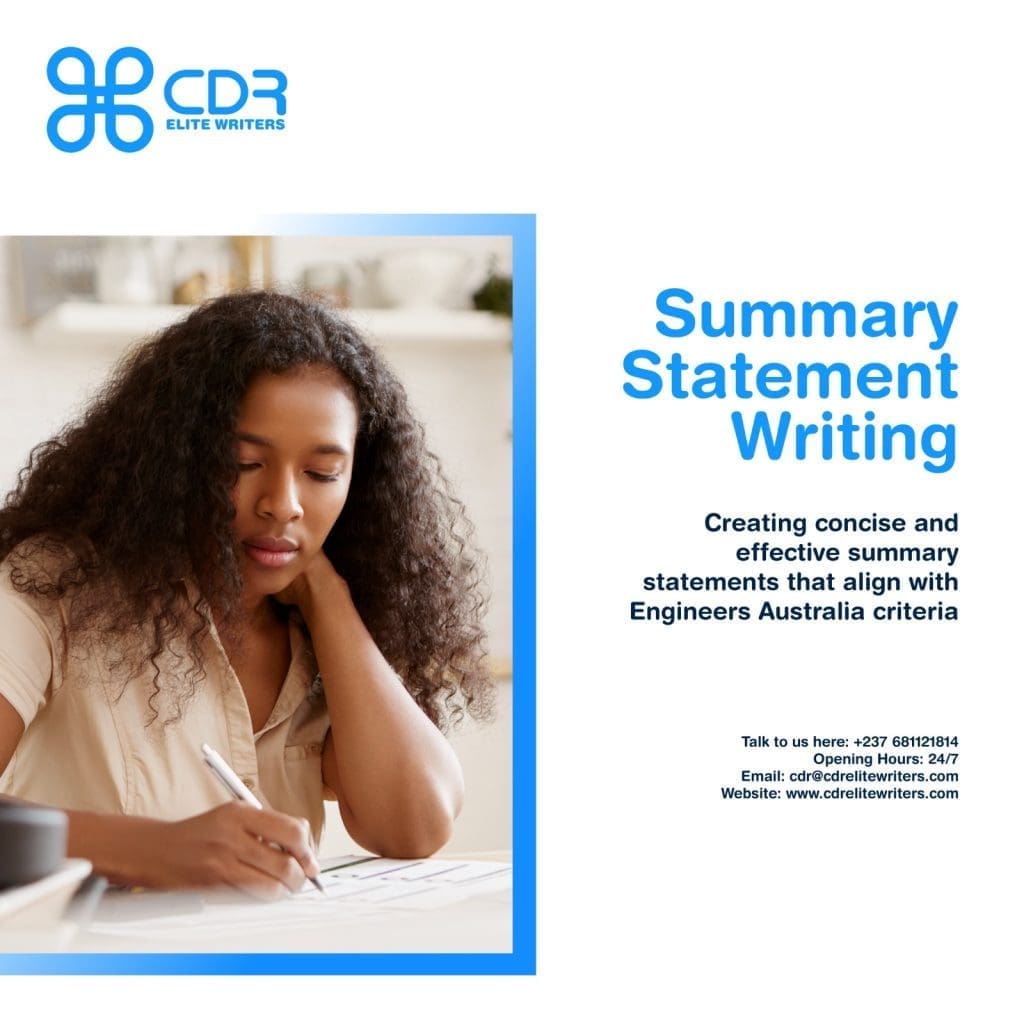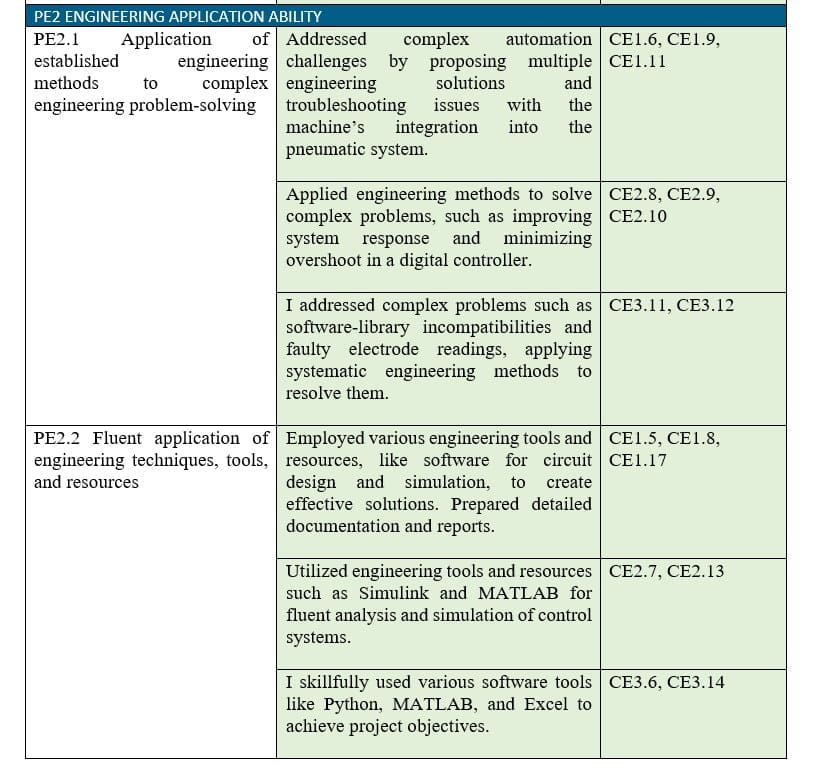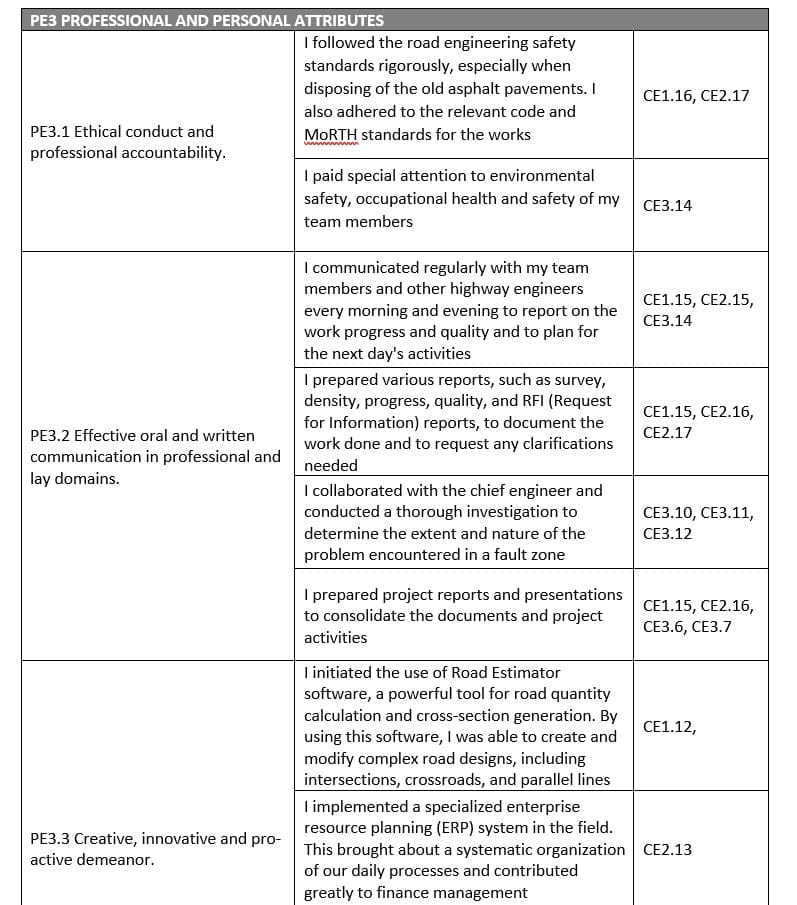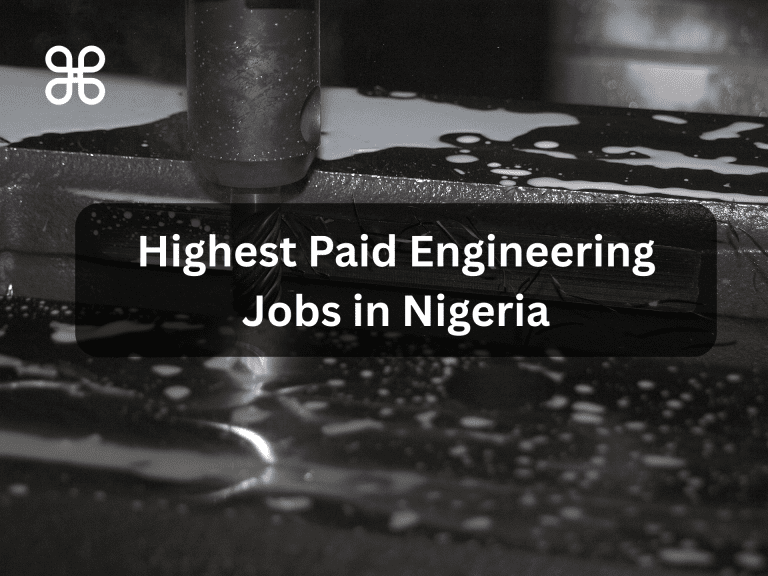
Introduction
The CDR Summary Statement highlights key engineering skills and management abilities in a table. It links career episode evidence to Australia’s engineering competencies. Moreover, it emphasizes work experience, education, and professional growth.
The CDR Summary Statement for Engineers Australia is a vital part of the Competency Demonstration Report (CDR) writing process. It’s where we highlight our skills and convince assessors that we fit our chosen job. Crafting this statement is like building a durable bridge. It needs careful planning, attention, and a clear understanding of its purpose.
According to the Department of Home Affairs, Australia (2017-2018 report), the country granted 116,000 permanent visas to engineers, and they were ranked first in the Skilled Occupation List (SOL). Furthermore, Engineers Australia reported that the country will need 100,000 more engineers by 2024. This underscores the importance of an effective CDR in securing an engineering position in Australia.
Department of Home Affairs, Australia. (2018). Migration Program Report 2017-18.
This guide explains the CDR Summary Statement for Engineers Australia in simple steps. It details what to include and how to organize each section.
Sections in the CDR Summary Statement
The Engineers Australia CDR booklet outlines three competency elements that must be addressed in the CDR summary statement:
1. Knowledge and Skills Base: Examples
Demonstrate your understanding of theoretical principles and technical knowledge relevant to your engineering discipline. Provide examples of how you’ve applied complex engineering theories or principles to solve technical problems.

1.1 Systematic, theory-based understanding of the underpinning natural and physical sciences and the engineering fundamentals applicable to the technology domain
- I used fundamental engineering practices with the adaption of physical sciences in the realm of civil engineering.
- I tackled a complex engineering problem that needed a grounding in underpinning natural and physical sciences.
1.2 Conceptual understanding of the mathematics, numerical analysis, statistics and computer and information sciences which underpin the technology domain
- I combined numerical concepts with research and technical skills to reach the specified project goals.
- I facilitated mathematical and statistical analysis by optimizing the design of a technological system.
1.3 In-depth understanding of specialist bodies of knowledge within the technology domain
- My research was enhanced significantly by my engineering understanding, leading to substantial improvements in the project results.
- I utilized my deep specialist knowledge in the technology domain to design and implement innovative solutions.
1.4 Discernment of knowledge development within the technology domain
My discernment of knowledge development was instrumental in identifying and addressing emerging challenges in the technology domain.
1.5 Knowledge of contextual factors impacting the technology domain
- In career episode 1.10, I undertook a project which was greatly improved by considering the impact of various contextual factors, leading to satisfactory results.
- I developed effective engineering solutions that were deeply grounded in understanding the influence of contextual factors in the technology domain.
1.6 Understanding of the scope, principles, norms, accountabilities, and bounds of contemporary engineering practice in the technology domain
I demonstrated a comprehensive understanding of contemporary engineering practice, which guided me to lead a successful project in the technology domain.
2. Engineering Application Ability: Examples
Highlight your proficiency in applying your knowledge to practical engineering tasks. This includes project management, understanding and applying relevant codes and standards, and utilizing engineering tools effectively.

2.1 Application of established engineering methods to broadly defined problem-solving within the technology domain
I tackled broadly defined problems in the civil engineering field using established engineering methods.
2.2 Application of engineering techniques, tools, and resources within the technology domain
I demonstrated proficiency in using engineering techniques, tools, and resources for optimizing project outcomes.
2.3 Application of systematic synthesis and design processes within the technology domain
- I realised the needed project goals in Career Episode 1.8 by implementing design processes.
- I employed systematic synthesis and design processes to develop a series of innovative engineering solutions.
2.4 Application of systematic approaches to the conduct and management of projects within the technology domain
I successfully conducted and analysed a project in the civil engineering field through the application of systematic approaches.
3. Professional and Personal Attributes: CDR summary statement Examples

3.1 Ethical conduct and professional accountability
I demonstrated a strong commitment to ethical conduct and professional accountability in my work.
3.2 Effective oral and written communication in professional and lay domains
I effectively communicated complex engineering concepts to different audiences, from peers to laymen.
3.3 Creative, innovative, and proactive demeanor
I assimilated newer techniques and methods, constantly adapting to the ever-changing technological landscape. This creative and proactive demeanour is essential for staying ahead in the field of engineering.
3.4 Professional use and management of information
I effectively managed and utilized information to address challenges and improve project outcomes in the technology domain.
3.5 Orderly management of self, and professional conduct
I displayed professional conduct and managed my responsibilities effectively as a team leader in a complex engineering project.
3.6 Effective team membership and collaboration
I played an active role in a multidisciplinary team, utilizing my effective team membership skills to achieve project goals in the technology domain.
To meet Engineers Australia standards, follow all guidelines and provide complete information in your CDR summary statement template. Use bullet points for clarity and address the reader directly to create a personal connection. Also, highlight the risks of not following steps to stress the need for accuracy and completeness.
In conclusion, a good CDR summary statement shows an engineer’s knowledge, application skills, and personal traits. By following the rules and using bullet points, you can clearly and briefly showcase your skills and competencies.
Enhancing Your CDR Summary Statement
To improve your CDR Summary Statement for Engineers Australia, make it clear and substantial. Highlight your direct role in engineering tasks. Use phrases like “I developed,” “I analyzed,” or “I implemented” to show responsibility and initiative. Simplify complex engineering ideas into brief, clear explanations. This ensures assessors understand your involvement and expertise.
Research by the American Society for Engineering Education (ASEE) indicates that soft skills in communication, teamwork, and leadership are increasingly desired by employers, with over 75% of engineering job postings mentioning these competencies.
A study by the Project Management Institute (PMI) found that 56% of engineering projects fail due to a lack of clear goals and accountability, highlighting the importance of clear and measurable achievements in demonstrating project leadership and success.
These statistics provide a convincing backdrop for applicants to meticulously curate their Summary Statements in line with Engineers Australia requirements.
For instance, you might say “I spearheaded a cross-functional team in redesigning the manufacturing layout, resulting in a 30% reduction in material waste and a 25% increase in overall productivity.”
Such statements not only exhibit your leadership skills but also offer concrete evidence of the benefits that ensued from your efforts.
Align CDR Summary Statement with Career Episodes
Your career episodes are pivotal narratives that illustrate your engineering experience and accomplishments. Aligning them with the competency elements in the Summary Statement is essential in creating a coherent CDR Report. Here’s how to effectively bridge the two:
- Identify the Competencies: Start by listing the competencies required for your engineering category as outlined in the Engineers Australia Migration Skills Booklet. Understanding these criteria is the initial step in ensuring alignment.
- Map Specific Experiences to Competencies: Review your career episodes and align specific tasks or projects with the competencies. For instance, if a competency pertains to design innovation, reference a particular episode where you solved a complex problem through a creative design approach.
- Use Precise Indicators: In your Summary Statement, use paragraph numbers as indicators to point to where in your career episodes you have demonstrated the required competency. This cross-referencing allows assessors to easily verify your claims.
- Demonstrate Progression: Ensure that the episodes collectively demonstrate your growth as an engineer. Subsequent episodes should build on previous ones, showing an evolution of your skills and increasing levels of responsibility.
- Be Concise, Yet Comprehensive: Your CDR Summary Statement should be precise but comprehensive enough to validate your competencies. Each paragraph should be directly correlated to the related instance in your career episodes without reiterating all details.
By conscientiously mapping your career episodes to the CDR Summary Statement, you create a powerful tool that affirms your qualifications and suitability for the engineering role you are targeting.

When detailing the connection between your practical experience and the required competencies, it is crucial to employ a strategic approach:
1. Highlight Outcomes
Emphasize the results and outcomes of your practical work. Align each outcome with a competency requirement, demonstrating how the experience directly contributed to your engineering skill set.
I undertook the project of designing a sustainable water filtration system for a rural community. The successful completion of this project resulted not only in an efficient and cost-effective solution but also had a substantial impact on the community’s health and wellbeing.
2. Use Quantifiable Evidence
Where possible, use metrics and tangible data to substantiate your competencies. Quantifiable achievements give assessors clear evidence of your capabilities and the impact of your work.
I was responsible for the development of a vehicular bridge designed to reduce traffic congestion in a fast-growing urban area. The bridge improved traffic flow by 30% as measured by local traffic management systems, I also achieved a 15% reduction in construction costs, compared to traditional building methods.
3. Incorporate Reflection
Include a reflective element in your descriptions, explaining how each experience helped you develop or enhance a specific competency. This demonstrates self-awareness and commitment to continuous professional development.
I encountered unexpected geological challenges that required me to think critically and adapt my design approach. This experience allowed me to develop my skills in problem-solving and effective communication with other team members, aligning with the competencies of “Application of Theory” and “Teamwork” , respectively.
4. Ensure Clarity
Be clear and concise in your exposition, using bullet points or numbered lists if necessary to enhance readability. Jargon and overly technical language can obscure the connection between experience and competency, so keep explanations accessible.
I replaced outdated hardware and implemented advanced software protocols to improve data transfer speeds across the company’s global operations. This technical achievement can be expressed with specific markers:
Before Upgrade: The company’s communication system had an average data transfer rate of 50 Mbps
After Upgrade: Post-implementation, the transfer rate increased to 200 Mbps, a 300% improvement.
5. Provide Context
Contextualize each project or task within your overall engineering practice, explaining its relevance and significance. This helps assessors understand the scope and complexity of your work and its relation to the competencies.
By integrating these strategies into your Summary Statement and career episodes, you will create a compelling narrative that underscores the vital link between your hands-on engineering experience and your professional competencies.
Potential Negative Outcomes if Proper Steps Are Not Followed
Failure to adequately follow the steps and guidelines for the CDR writing can lead to several negative outcomes, including:
- Rejection or Delay in Assessment: If your CDR does not meet the Engineers Australia criteria, it may be rejected or require resubmission, leading to significant delays in the assessment process.
- Inability to Demonstrate Competency: Without clear, specific examples linked to the competency elements, you may fail to convince the assessors of your suitability for the engineering occupation category for which you are applying.
- Misrepresentation of Skillset: An inadequately prepared CDR may not accurately reflect your skills, knowledge, and experience, potentially hindering your career progression or opportunities.
Need Help?
Crafting a compelling CDR Report is no easy task, but remember, you’re not alone. If you need assistance, whether it’s understanding the ACS skill assessment occupation list, calculating your Australia skills assessment points, or simply getting a professional eye on your CDR, don’t hesitate to seek help.
CDR Elite Writers, a team of experienced CDR report writers and engineers, are ready to assist you. With a deep understanding of the Engineers Australia CDR requirements, they offer comprehensive CDR report writing services in Australia, ensuring your CDR Report Sample stands up to scrutiny and maximises your chances of success.
For more information, visit CDR Elite Writers today. Let us help you build a CDR sample summary statement Report that bridges the gap between your engineering dreams and reality.




